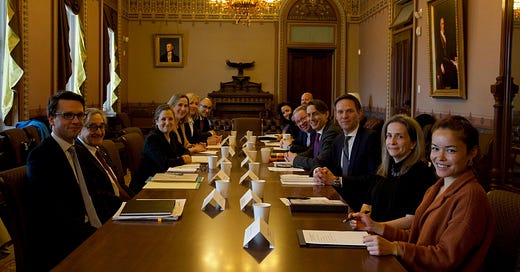The middle ground between “public” and “secret” is vast, and it’s where most of the fun is. The above photo appeared, I learned just now, on Chrystia Freeland’s Twitter account a week ago, on May 2. So it’s pretty public. It’s from the first meeting, in Washington, of the Canada-US Energy Transformation Task Force, whose creation was announced when Joe Biden came up to visit Justin Trudeau at the end of March.
The Canadian communiqué from the Biden-Trudeau meeting says this about the task force: “To accelerate cooperation on critical clean opportunities and supply chains, Prime Minister Trudeau and President Biden agreed to launch a one-year Energy Transformation Task Force, chaired by one representative from the White House and the Deputy Prime Minister.” The “Joint Statement” from Biden and Trudeau adds a bit more detail, including the title of the one representative from the White House: It’s the U.S. Special Presidential Coordinator for Global Infrastructure. Hurrying to the Google machine, I learned that person is Amos Hochstein, about whom more in a minute.
The photo hints at answers to questions that arose from the joint statement. How big a deal is this task force? Well, at the table with Freeland (third from the front on the left) and Hochstein (fourth from the front on the right) are Kirsten Hillman, Canada’s ambassador to Washington, and David Cohen, the U.S. ambassador to Ottawa. Michael Sabia, the deputy minister of finance, is to Freeland’s right, or rather, to the right of whoever got up from the table to take the photo. Leslie Church, Freeland’s chief of staff, is next to Hillman. I’m sorry to say I don’t know the others.
Clearly this meeting, and the process it inaugurated, were a big enough deal to get Sabia and Cohen on flights to Washington. It would be surprising if it were otherwise. The “energy transition” from higher- to lower-carbon sources is Job One in Justin Trudeau’s Ottawa, and Challenge One is ensuring the Americans don’t get too far out ahead, or leave us behind. This is why there is a $13 billion battery plant. Probably nobody at the table had something more important they were sorry to be missing.
What does this table discuss? The White House published a readout, the term of art for an official account of a meeting or call. In it, we learn they think “Task Force” is one word. Everything in bold in these excerpts is my emphasis, for clarity and to help you scan quickly:
The Taskforce will work with departments and agencies across both governments to accelerate cooperation on critical clean energy opportunities and supply chains, including but not limited to, securing and strengthening renewable energy and electric vehicle supply chains, critical minerals, grid integration and resilience, current and next generation civil nuclear technologies, and other areas that advance our collective energy security, and to avoid and reduce disruptions to our integrated and complementary supply chains.
At the Taskforce meeting, the United States and Canada affirmed their commitments to our shared priorities to deploy clean energy solutions at scale, electrify our economies, and support the development of critical mineral and electric vehicle supply chains that will fuel the future North America automotive industry. The co-chairs further refined strategic priorities and next steps for the year-long Energy Transformation Taskforce.
One gets used to other countries’ accounts of bilateral meetings being more informative than Canadian accounts, but this time appearances are deceiving. The White House readout is the same paragraph twice. And the first paragraph is actually a verbatim cut-and-paste from the March Trudeau-Biden joint statement.
The Canadian account of the meeting might actually be more complete, though I had trouble loading it on a 21st-century web browser. As often in diplomatic exchanges, it recounts only what the Canadians said. Excerpts:
The Deputy Prime Minister spoke about Canada’s plan to… supply the critical goods and resources that our allies need. She commended the United States for its support of Ukraine as it defends its sovereignty and democracy….
She highlighted that Canada and the United States are natural partners in developing a reliable supply of the critical minerals…
The Deputy Prime Minister noted that Canada is a key partner for the United States in developing clean energy technologies, including nuclear, and strengthening North America’s clean power grid, and emphasized the need to preserve the competitiveness of cross-border supply chains, including for steel and aluminum.
The Deputy Prime Minister underscored the importance of Canadian and American clean economy investments being complementary to each other…
Moving delicately past the amount of chutzpah it takes for a Canadian to commend the Americans on taking Ukraine seriously, we see clear agreement on the list of topics discussed. This was a meeting, and seems to announce a process, on safeguarding Auto Pact supply chains, smart grid, critical minerals and, mostly, small modular reactors.
Which brings me to a topic not listed, one that tends to come up at just about any other meeting Amos Hochstein attends.




